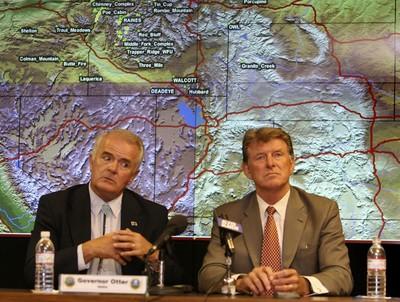Gibbons joins battle against weed that fuels wildfires
BOISE, Idaho -- Four Western governors declared war Monday on cheatgrass, a nonnative weedy grass they blame for filling the West's open spaces with flammable fuels feeding this summer's massive wildfires.
Still, their efforts could be complicated by a shortage of seeds of other grasses needed to restore the charred landscape before cheatgrass takes hold. In fact, some of the federal Bureau of Land Management territory where such seeds are collected has been burned.
And environmentalists are leery about the plans for replanting, fearing they'll concentrate on grasses that provide forage for livestock rather than native vegetation that helps wildlife such as sage grouse.
Idaho Gov. C.L. "Butch" Otter hosted the meeting with Govs. Jon Huntsman from Utah and Jim Gibbons of Nevada. All three are Republicans. Wyoming Democratic Gov. Dave Freudenthal participated by phone.
So far this year, wildfires in Idaho, Nevada and Utah have burned thousands of square miles, including the giant Murphy Complex fires on the Idaho-Nevada border that torched an area as large as Rhode Island.
By Sept. 1, the governors want a pilot project that will include planting grasses, in hopes of preventing cheatgrass from gaining a greater foothold. Their program will also include new cross-border pacts aimed at helping states share resources and gear when fires erupt, the governors said.
"Our agreement was premised on the idea of declaring war on cheatgrass," Gibbons told reporters at a Boise news conference. "It's more than just burning grass out there -- it's an economy at risk, it's state resources that are at risk, it's the environment that's at risk."
Land managers must still determine how many acres the pilot project will encompass.
A big hurdle to the governors' reseeding plans: Officials say there aren't enough seeds to go around.
Every year, about 80,000 acres of federal land in the three states sees restoration, the governors said; this year, more than 10 times that area burned.
In the last decade, surveys by U.S. Forest Service scientists at the Forest Service's Rocky Mountain Research Station in Provo, Utah, show that 2.5 million pounds of grass seed were needed annually for restoration projects -- but that only 765,000 pounds were available, half from collecting seeds on public land and half produced by private companies.
In intense fire years that torch thousands of square miles, the bottleneck is even more dire, said Durant McArthur, a Forest Service research geneticist in Provo. That leaves more ground vulnerable to fast-spreading cheatgrass.
Federal officials including U.S. Interior Secretary Dirk Kempthorne have said a combination of factors, including drought, high temperatures and intense lightning storms led to the massive fires.
However, Otter has criticized federal wildland firefighters for not reacting quickly enough.
He and U.S. Sens. Larry Craig and Mike Crapo last week also chastised environmental groups such as the Hailey, Idaho-based Western Watersheds Project for filing (and winning) lawsuits in U.S. District Court that reduced cattle grazing. That increased dry fuels, adding to the fires, the Idaho Republicans contend.
Environmentalists contend livestock grazing contributes to the spread of cheatgrass and subsequent wildfire danger.
LV HAZE CAUSED BY CALIFORNIA FIRE Smoke from a Southern California wildfire 300 miles away turned the skies over Las Vegas into a hazy shade of gray Monday. National Weather Service meteorologist Charlie Schlott said smoke from the monthlong Zaca fire in the Los Padres National Forest northwest of Santa Barbara, Calif., had drifted into the Las Vegas Valley after a flare-up this weekend. Visibility in Las Vegas was cut down to 19 miles at times with a maximum range of 47 miles, according to Clark County air quality officials. Any visibility reading less than 10 miles is considered poor. Local monitoring stations didn't record excessive levels of particulate matter but "that doesn't mean it's not hazy or dusty out there," said Joe Hameed, Clark County's air quality monitoring supervisor. The Zaca fire began July 4 and was nearly contained two weeks later. A flare-up Friday, however, left the wildfire only 68 percent contained and forced the evacuation of homes while chaparral and hardwood trees were ablaze. The Zaca fire has burned 63,350 acres in a 20-mile stretch near Buellton, Calif., located about 300 miles southwest of Las Vegas. REVIEW-JOURNAL

















